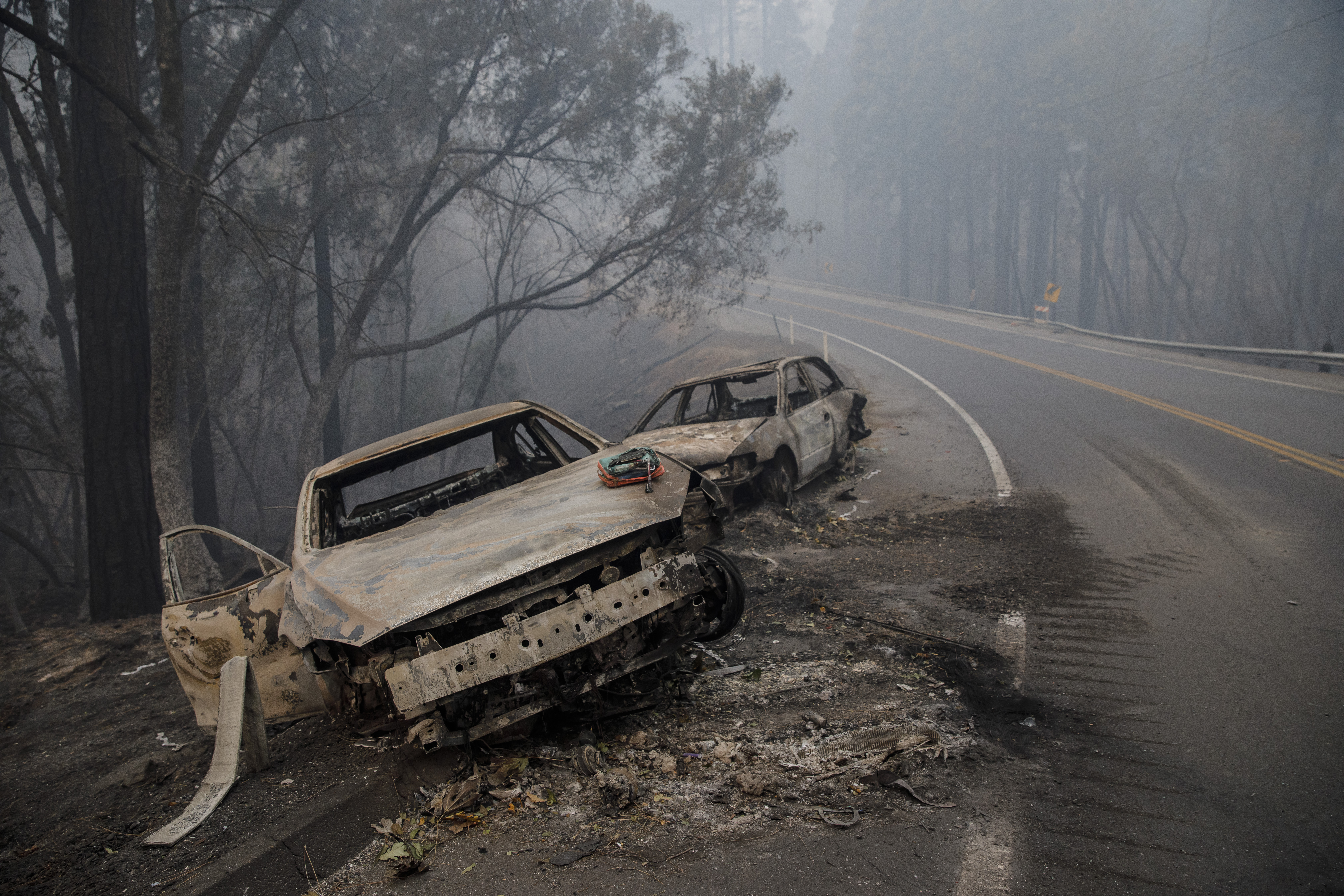Ahead of Camp Fire Anniversary, New Details Emerge of Troubled Evacuation

Cars destroyed by the Camp Fire sit on the side of the road in Paradise, Calif., on Nov. 15, 2018. (Marcus Yam /Los Angeles Times via Getty Images)
In the frenzy of California’s deadliest-ever wildfire, officials tried but failed to activate a free emergency notification system that might have warned more people of the blaze, FRONTLINE has learned.
The Camp Fire on Nov. 8, 2018 torched the foothill town of Paradise in Butte County, killing 85 people. Many people died in their homes, or cars as they tried to escape. The fire severed evacuation routes, gridlocking traffic.
FRONTLINE investigated the disaster for the documentary Fire in Paradise, which airs Oct. 29, to find out what went wrong in Butte County last November.
The morning the fire sparked, a single staff member at the Butte County Sheriff’s Office coordinated the evacuation orders, using a newly contracted software package called CodeRED. The program has the ability to send emergency evacuation alerts separately to 14 zones in the town, or a mass message to Paradise residents.
The staffer initially chose the zone-by-zone alerts “for no other reason than the overwhelming and chaotic nature of the situation,” Megan McMann, a spokesperson for Butte County Sheriff Kory Honea, said in an email. Evacuating by zone can also prevent traffic from overwhelming the main evacuation routes out of town, Paradise Fire Chief David Hawks told FRONTLINE.
But the zone-by-zone alerts only go to residents who sign up to receive them. By the day of the fire, fewer than half of Paradise’s 26,000 residents had registered for the optional service.
As the fire worsened, the sheriff’s office said the staffer also tried to use the CodeRED system to send mass alerts through the national Integrated Public Alert and Warning System (IPAWS). The free government resource, which is managed by the Federal Emergency Management Agency (FEMA), sends wireless emergency text alerts, known as WEA, to all compatible mobile devices in a specified area.
It didn’t work, according to the sheriff’s office.
Though the staffer made several attempts to use IPAWS on the day of the fire, “those WEA messages were not successful,” McMann said, adding that the staffer did not realize the messages hadn’t sent until the following day. The Butte County Sheriff’s Office does not know why the alerts failed. McMann said the county is now working with the software company behind CodeRED, OnSolve, to find out what went wrong.
Troy Harper, OnSolve’s public sector general manager, said the company doesn’t have any record that Butte County tried to use IPAWS on the day of the fire, although OnSolve can only see messages that have been saved in the system by users. He said there is a record of messages that could be WEA alerts from Nov. 9, 2018 and Nov. 10, 2018 – but these were never sent.
In a written statement to FRONTLINE, FEMA said there is also no record in its system of wireless emergency alerts sent from Butte County between Nov. 8 and Nov. 10, 2018. The agency said it is also unaware of any issues the sheriff’s office may have encountered. Nobody contacted its agency for help, FEMA said.
Whether or not a blast of WEA messages would have improved the outcome in Paradise is almost impossible to know, said Art Botterell, an emergency management specialist who consults with clients, including PBS, on emergency notifications.
Botterell previously worked as the emergency services coordinator for the California Governor’s Office of Emergency Services, but retired two years ago, “disappointed to the point of rage” over the attitude he witnessed toward public warnings in the state.
His son-in-law was among the people who evacuated Paradise in a dramatic, last-minute drive down roads flanked by flame. Botterell said he still wonders whether his son-in-law would have taken the fire more seriously had Butte County sent a mass alert sooner, in addition to zone-by-zone evacuation instructions.
“It’s generally better for people to know what’s going on than not,” Botterell said. “The alert helps people confirm their speculation about what’s going on.”
Authorities may hesitate to send mass alerts because they want to prevent panic that could complicate evacuations, Botterell said.
One year before the Camp Fire, the Butte County Sheriff’s Office oversaw the chaotic exodus of more than 180,000 people from the region, following damage to the local Oroville Dam spillway. Similar to the Camp Fire evacuation, the surge of fleeing people clogged roads and slowed traffic. Butte County hired OnSolve the same year, which allowed for zone-by-zone evacuations through CodeRED.
Paradise officials were aware that sign-up for the service was low, leading up to the Camp Fire, said Emergency Operations Manager Jim Broshears. Their “big campaign for 2019” was to increase participation, he added.
Yet when the fire hit, many of the messages failed to reach even the people who did sign up.
The Camp Fire burned so quickly and fiercely – damaging communication cables and cell towers – that it disrupted the CodeRED evacuation orders, according to a report published in June by the Butte County Grand Jury. Moreover, the blaze cut electricity to TV, radio and internet. Only 7,000 of the 52,000 people who evacuated the affected area received alerts about the approaching wildfire, according to the report.
“The CodeRED system’s dependency on telephone service is an inherent weakness of the warning system,” the grand jury concluded.
Though it’s unclear at what point the fire damaged cell phone towers beyond function, the WEA messages would at least have bypassed jammed signals. The system is not affected by network congestion, according to FEMA.
One year prior to the fire in Paradise, communication failures also complicated evacuations from Sonoma County in northern California. Multiple fires converged there in October 2017. The county chose not to use the IPAWS wireless emergency alert system, relying instead on a combination of opt-in notifications run by private companies. An investigation by the California Governor’s Office of Emergency Services found Sonoma County did not use IPAWS because of a limited understanding of how the system works.
Largely in response to the 2017 fires, California amended its Government Code to improve emergency alerts by mandating guidelines for public warnings – approved by the governor less than a month before the Camp Fire hit Paradise. The legislature declared the size and scope of wildfires had grown significantly, risking the lives of millions and therefore “the need to alert residents of dangers from these unprecedented disasters has never been greater.” The guidelines, which were due to be completed by July 2019, will be distributed to each city and county in the state.
New guidelines are unlikely to resolve problems underlying California’s public alert system, Botterell said, because the state relies too heavily on local authorities to coordinate emergency notifications through the private sector. As a result, the system is fractured between competing software companies in a way that complicates any standardized training.
Though Butte County will continue to use CodeRED, the Butte County Grand Jury has called for officials to adopt a multi-platform emergency notification system by the end of the year. The sheriff’s office has also developed a protocol with OnSolve to send duplicates of future CodeRED messages through IPAWS, as well as installing evacuation sirens on its police vehicles.






